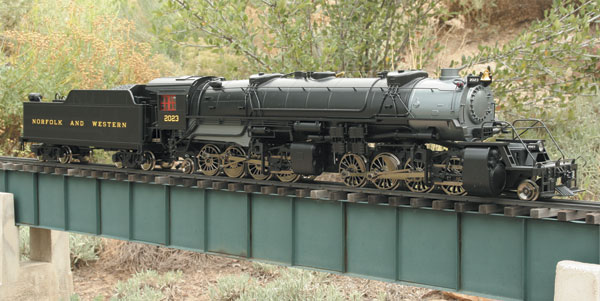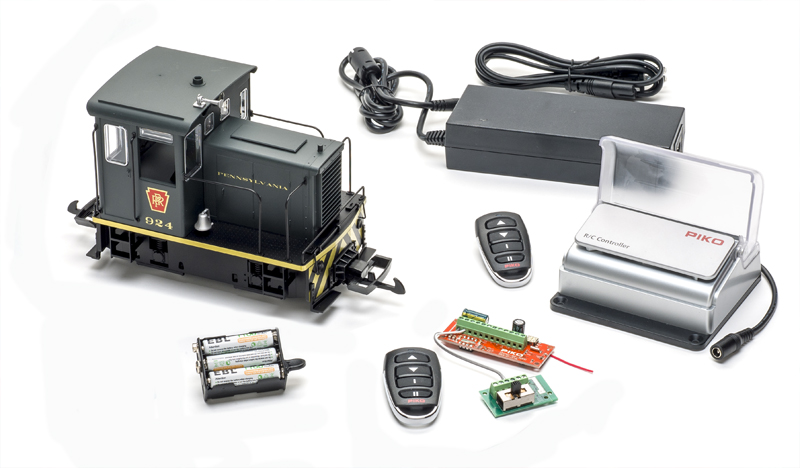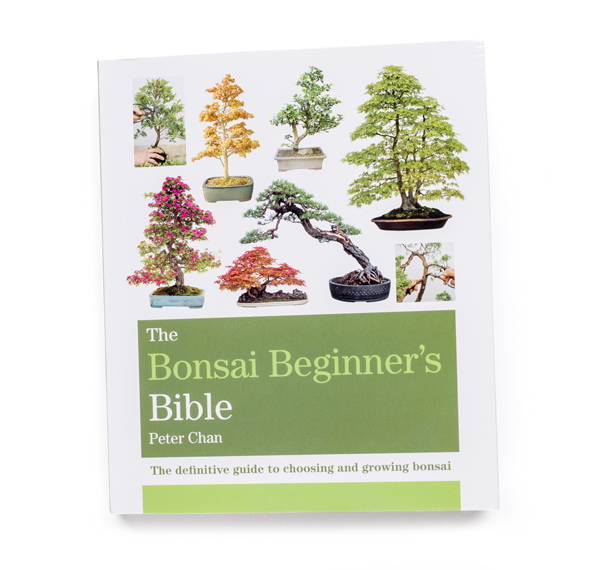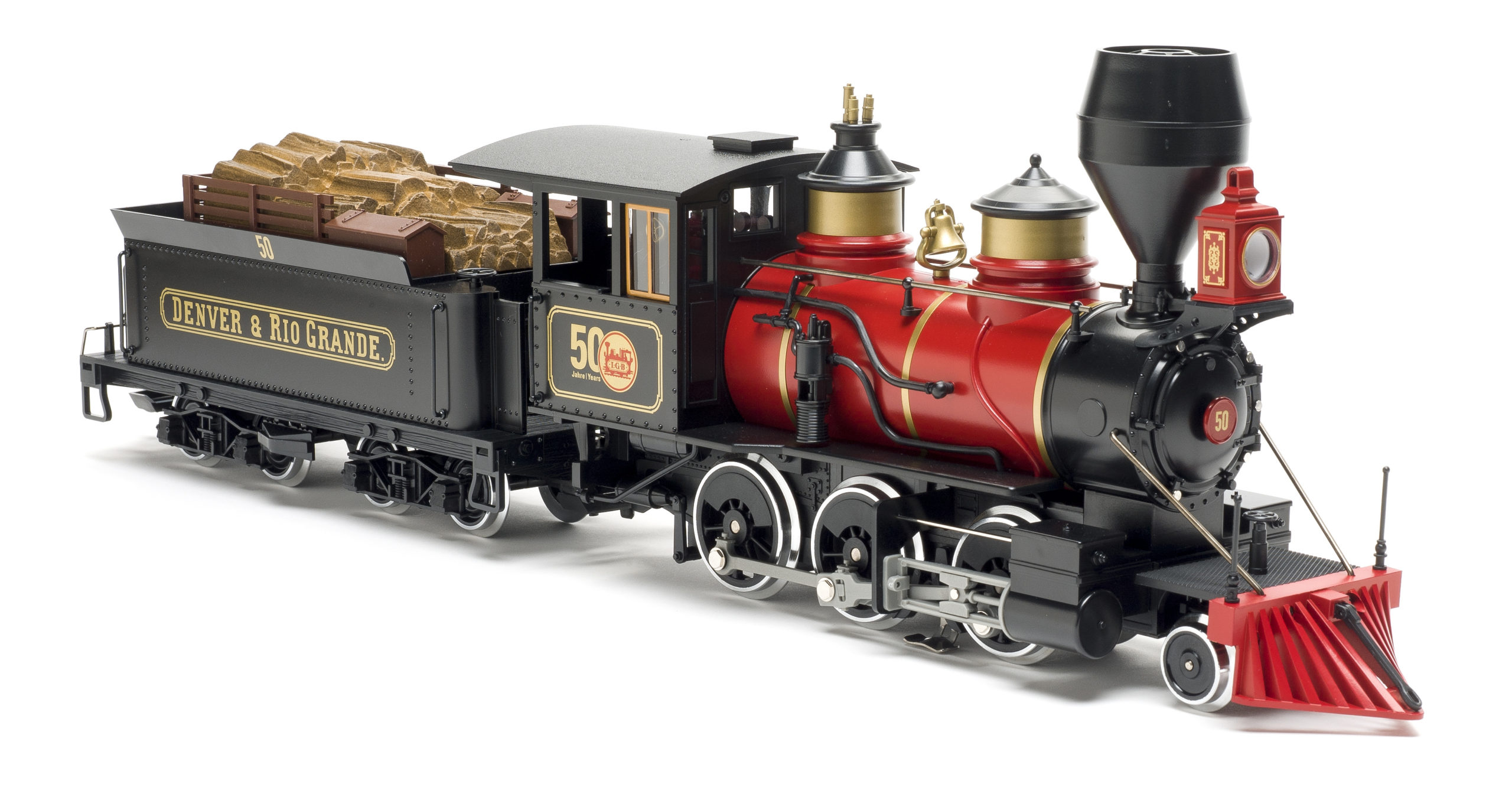1:29 scale, gauge 1 2-8-8-2 locomotive
Aristo-Craft Trains
698 South 21st St.
Irvington NJ 07111
Price: $945 ($993 for Union Pacific)
Web site: www.aristocraft.com
Plastic-and-metal model of a USRA 2-8-8-2 Mallet locomotive; USRA or Vanderbilt tender, depending upon road name; smoke unit; sound ready; DCC ready; battery ready; control switches under firebox; two motors with flywheels and fans; all axles powered through modular gearbox on each axle; 32 ball bearings (four per driven axle); 16 electrical pickup points in locomotive (more in tender); illuminated headlight, rear light, markers, cab, and number boards; knuckle and hook-and-loop couplers supplied; detail molded in and added on; diecast wheels and valve gear; motor blocks pivoted to boiler; Baker valve gear; multiple-unit plugs; multiple-position drawbar; instruction booklet included. Dimensions: Length overall (engine and tender), 43 1/4″; width, 4 7/16″; height, 6 5/8″. In 1:29 scale, this works out to 104′ 6″ x 10’8″ x 16’0″, respectively. Tractive effort: 4 pounds 12 oz., or enough to pull approximately 61 average freight cars on straight, level track, Current draw: 4 amps at 20V, wheels slipping
Pros: Reasonable fidelity to prototype; reasonable detail level; excellent paint and graphics; effective smoke unit; ready for installation of sound, DCC, and/or batteries; excellent drive system; very quiet
in operation; reasonable top speed; adequate slow-speed response-will probably improve with use; generally smooth running; excellent tractive effort; will negotiate radii down to 4′; lateral and angular play in drivers; back-to-back wheel dimensions consistent at 1.575″; tender exceptionally free rolling
Cons: Over-deep wheel flanges; inconsistent flange depth (drivers not as deep as other wheels); glossy, metallic finish on drivers, rods, and valve-gear parts; some details crudely done; drawbar not adjustable to prototype engine-tender spacing; dim lighting-hard to see in full sun; slight wobble in front end; unprototypically thin driver rims
Aristo-Craft’s model is based on a Norfolk & Western engine, for which our review sample is lettered. It is supplied with a USRA tender (other road names have Vanderbilt tenders with six-wheel trucks). The boiler shell is molded in ABS plastic, with some molded-in detail. Other details are applied to the engine separately. The level of detail is adequate, although there is plenty of opportunity for adding more, should you wish. The details themselves are generally pretty well done, although some appear crudely rendered (underbody detail on the tender, for instance). The overall effect is good, though. On the prototypes, details would vary from railroad to railroad, so, as supplied, details may be incorrect for different roads. Aristo-Craft is offering the engine in 11 different road names.
This locomotive has two can motors (one per power truck), each equipped with flywheels and cooling fans. Each motor is connected to a drive shaft that powers each axle through worm gears. There are four ball bearings per axle, making for a smoothly operating mechanism. The engine was designed to negotiate four-foot-radius curves (far tighter than the prototype could manage). For this reason, both power trucks are pivoted to the boiler independently of one another. While this is definitely unprototypical, it does allow the engine to achieve its maker’s goal. The fact that both steam motors are pivoted is less noticeable on wide-radius curves. There is both lateral and angular (in the vertical direction) play in all driven axles, allowing the engine to negotiate some pretty raggedy track. However, it looks far better on well-laid track and smooth, broad curves.
Drivers, rods, and valve gear are diecast metal. These, along with the lead and trailing wheels, have a weird, glossy, metallic finish that mars the engine’s appearance. The judicious application of paint should solve that problem. The lead and trailing wheels, and the tender wheels, are further marred by over-deep flanges. The model is fitted with prototypically correct Baker valve gear.
A knuckle coupler comes installed on the tender and one is provided for the pilot. However, after installing the pilot coupler, the engine will not go back into its box without modification of the styrofoam insert. Hook-and-loop couplers are also supplied. Cables and plugs are built in for double-heading locomotives and other uses. These hang off the front and rear ends and I found them to be unsightly. Similar cables pass between the engine and tender. One is for battery operation and the other is a power-pickup plug, providing additonal pickup points for the motors.
The tender comes equipped with a speaker, should you wish to install a sound system. Tender trucks are both sprung and equalized. The tender is weighted and is exceptionally free rolling. The tender is connected to the engine with a drawbar that can be adjusted to six different lengths, depending on your radius. However, even at closest coupling, the locomotive is still unprototypically far from the engine. More holes could be drilled in the drawbar for prototypical coupling, if your railway has the wide-radius curves necessary to accommodate it.
Radio control with battery power or DCC can be installed in this engine with just a little work. The top of the boiler must be removed with six screws. The instruction book included with the engine includes a diagram of the main circuit board and information pertinent to these installations.
Beneath the firebox are four switches, two on each side. One each turns the motor, lights, or smoke unit on or off. The fourth switch is a battery switch, which will isolate the engine from track power, for onboard-battery operation.
The instruction booklet provided with this engine covers all basic information. There is a little ambiguity here and there (we are told to turn the smoke unit off when filling, but are never told when to turn it back on, for example).
On the track, the engine performs well. Top speed is, perhaps, a trifle fast, but is not unreasonable. Slow-speed operation is good, although there seems to be a tendency for the engine to stick a little when starting. This may work itself out with use, as the parts wear into each other. Even at full speed, the engine is quiet, so there will be little ancillary noise to interfere with an aftermarket sound system. There was a slight lope in our review sample, and a noticeable wobble in the front end. Again, these-especially the lope-may work themselves out in time.
The smoke generator is particularly effective, though it might benefit from a larger reservoir. A fan helps to propel the smoke up and out of the stack and, while it is not synchronized to the pistons, it does look quite good. Lighting seems to be semi-directional; that is, the rear light came on when the engine backed, but the headlight stayed on all the time. All lights are pretty dim and, in bright sun, you can’t see the markers or number-board lights at all.
Overall, this is a fine piece of work. It’s big and heavy, captures the spirit of the prototype, and it runs well. It should haul a prodigious train and would look grand traversing broad, sweeping curves with a freight drag in tow.














